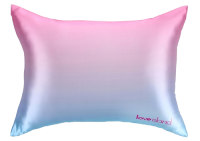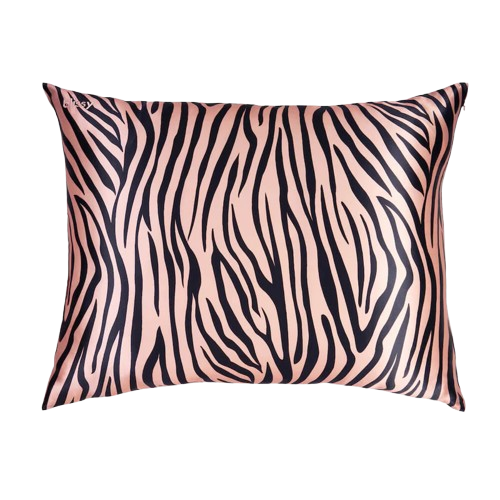Key Takeaways:
-
Sateen is a cotton weave, not a fiber, designed to mimic silk’s sheen.
-
Silk is naturally breathable, moisture-wicking, and hypoallergenic.
-
Sateen absorbs moisture and wears out faster than real silk.
-
100% mulberry silk offers unmatched softness, durability, and skin benefits.
Trying to decide between sateen vs silk? You’re not alone. With so many options—including satin—choosing the right fabric can be confusing.
This guide breaks down sateen vs satin vs silk to help you compare feel, breathability, and long-term benefits. Whether you’re looking for a cooler night’s sleep, fewer face creases, or a gentler option for sensitive skin and hair, understanding the real differences between these fabrics will help you choose smarter.
Sateen vs Silk and Satin: A Closer Look

Section Takeaway
While sateen provides an affordable entry point to luxury bedding, it lacks the exceptional quality, moisture-wicking, and anti-aging benefits of pure silk fabric. For true performance, comfort, and long-term skin and hair health, silk and satin are in a different class.
What Is Sateen?
Sateen is not a fabric, but a type of weave pattern—typically applied to cotton or other fibers—that gives bedding its silky feel and subtle sheen. The term "sateen" refers to the way the fabric is woven, not the raw material itself.
To create the sateen weave, four or more weft (horizontal) threads float over a single warp (vertical) thread. This technique exposes more surface thread, creating a smooth texture with a lustrous finish similar to that of satin sheets. The reverse side is denser and less glossy.
Sateen vs Silk Fabric: What's the Difference?
It’s important to distinguish sateen from silk:
-
Silk is a natural fiber, harvested from silkworm cocoons and used to make silk bed sheets and silk pillowcases.
-
Sateen is a cotton-based weave, often used to replicate the look and feel of silk and satin.
How Does Satin Bedding Compare?
Satin is often confused with both silk and sateen, but it refers to a weave, not a fiber—just like sateen. While satin bedding may be made from synthetic fibers like polyester or nylon, it still offers a smooth texture and glossy finish that mimics silk fabric.
However, satin lacks the natural breathability, moisture-wicking, and hypoallergenic properties of silk bedding. It can also retain heat and may not be ideal for hot sleepers or those with sensitive skin. If you’re deciding between satin vs silk, silk remains the premium choice in both comfort and long-term fabric performance.
Why Sateen Is Popular for Bed Sheets
Most cotton sateen sheets are made from combed or carded cotton to enhance softness. Some manufacturers may use synthetic fibers like rayon to mimic the drape of satin bedding, but these don’t offer the temperature regulating properties or breathability of silk bedding, which is naturally extremely breathable and ideal for hot sleepers.
Further reading:
How Silk and Sateen Feel Similar at First Glance

Section Takeaway
Sateen may offer a smooth feel, but it falls short of the exceptional quality and long-term benefits of real silk bedding—especially when it comes to beauty sleep and temperature control.
At a surface level, sateen shares some comparable traits with silk. The weave used to create sateen aims to mimic the smooth, fluid drape and subtle sheen of silk. Both fabrics have a soft hand feel and silky texture that feels gentle on skin. Although, as you're about to find out, one has a much more silky and gentle texture than the other.
Sateen and silk are also both promoted as breathable fabrics that help regulate body temperature. This makes them popular choices for sheets and pillowcases.
However, even though sateen shares some outward similarities with silk, even just touching the fabrics reveals clear differences in how they look and feel.
Further Reading:
Which Is Higher Quality Bedding —Silk or Sateen Sheets?

Section Takeaway
Silk bedding outperforms sateen across the board—it's more durable, naturally hypoallergenic, and better at regulating body temperature for hot sleepers. For those seeking exceptional quality and a truly luxurious feel, 100% silk sheets remain unmatched.
Sateen can seem like a low-budget way to get the benefits of silk, like that smooth surface, but it doesn’t quite meet the standard.
Durability Over Time: Silk Lasts While Sateen May Fray
Sateen sheets are typically made from cotton fibers, but it’s not the same thing as Egyptian cotton sheets. This cotton blend is more likely to start pilling and snagging with use. That means sateen pillowcases will become uncomfortable at some point.
Silk is known for its durability. When cared for properly, a high-quality silk pillowcase has a long lifespan.
Moisture Management: Sateen Absorbs, Silk Wicks for Optimal Sleep
One key difference between sateen and silk is how they handle moisture. Cotton-based sateen absorbs and retains moisture, while silk regulates it.
As you sleep, sateen sheets and pillowcases soak up perspiration, body oils, and beauty products applied before bed. This moisture gets trapped in the fabric, leaving it wet and promoting bacterial growth. The result can be increased acne breakouts and facial creases from skin adhering to damp sateen pillowcases.
Excessive moisture can also damage sateen fibers over time. The cotton threads expand when wet and then break down. This leads to pilling, thinning, and shorter lifespan of the fabric.
In contrast, silk has a molecular structure that absorbs moisture vapors while remaining dry to the touch. Instead of trapping sweat and oils, silk allows quick evaporation so you stay comfortable and the fabric retains integrity.
Silk's moisture-wicking properties also prevent product absorption, allowing its benefits to remain on skin and hair overnight. This makes silk the superior choice for a healthy, beauty-restorative sleep environment.
Healing Benefits: Silk's Natural Proteins Promote Skin Health

While both silk and sateen sheets have natural fibers, only one has protein fibers. Silk is between 70 and 80 percent fibroin and 20 to 30 percent sericin. There is evidence that sericin can help with wound regeneration and healing. So it is known for its powers to fight aging. It also has antimicrobial properties, keeping your skin clean and clear of acne.
You won’t find either fibroin or sericin in sateen sheets or pillowcases.
Staying Cool: Silk's Superior Breathability
Silk and sateen are both hailed as breathable fabrics. But when it comes to temperature regulation, silk outperforms sateen.
Sateen's blend of thick, dense cotton traps heat and moisture. The water-loving cotton fibers absorb sweat and hold it close to the skin, creating a hot and clammy sleep environment.
In contrast, silk has an innate ability to maintain optimal sleeping temperature. The natural structure of silk regulates heat by trapping air between protein fibers for insulation while allowing body heat to escape.
Silk also wicks moisture away from the skin and dries rapidly, keeping sleepers cool and comfortable. The silk fibers silkworms spin to form cocoons impart natural cooling properties.
So while sateen and silk both boast breathability, silk's superior airflow and temperature control offer unparalleled sleeping comfort. For hot sleepers, silk is the clear choice for cool, dry slumber.
Allergy Alleviation: Silk Repels Irritants, Sateen Traps Them

Silk is naturally hypoallergenic. The protein fibers repel irritants such as dust mites and pet danger. On the other hand, the cotton fibers that make up sateen sheets have the opposite effect.
Cotton traps things between its fibers, including allergens. As a result, dust, pet dander and even bacteria build up in cotton bed linen. Since cotton is a breathable fabric, it releases some trapped allergens into the air. Sateen is more hypoallergenic than low thread count cotton percale because of the tighter weave but not as much as silk. Since pillowcases sit right next to your head, you want the most hypoallergenic fabric possible.
Luxury That Can't Be Imitated
Even though sateen sheets add luxury item to your sleep space, it doesn’t compare to silk. Sateen sheets and pillowcases are not as soft nor comfortable as silk.
Silk is the gold standard for a reason. For its glimmering shine, durable strength, and unparalleled softness, this material has been sought after for centuries.
Where Sateen Has the Edge

Section Takeaway
Sateen offers a more affordable and low-maintenance alternative to silk, with a heavier feel and easy care. While it mimics the smooth texture of silk bedding, it lacks the natural fiber benefits and luxury of true silk pillowcases.
The biggest thing sateen brings to the table is affordability. Sateen sheets and pillowcases are typically more affordable than high-quality silk. If you are someone that likes a heavier feel for your bed linen, then sateen sheets offer that, too.
In some respects, sateen is also easier to care for than silk. It is naturally wrinkle-resistant and easily machine washed. Some silk, like from Blissy, can be machine washed as well, but the gentle cycle and air drying are recommended.
With cotton sateen, you can usually put it on the regular cycle and tumble dry it. There's a little more thoughtfulness involved in the care of a fabric as luxurious as silk.
Why Silk Remains the Gold Standard for Pillowcase
When shopping for bed sheets and pillowcases, it's important to understand the key differences between materials like Egyptian cotton sheets, percale sheets, and sateen fabric. While sateen sheets aim for a luxurious silk-like appearance with their subtle sheen and smooth weave, discerning consumers recognize they fall short of real mulberry silk's opulence.
The bespoke bedding favored by discerning consumers relies on the unparalleled softness, breathability, and durability of high-momme mulberry silk. Sateen bed linen may exude some silk-like aesthetics initially but lacks the longevity, cooling comfort, and wrinkle resistance of quality silk sheets.
Ultimately, no amount of spinning and weaving of cotton or other yarns can truly replicate the pampering properties of pure silk's natural protein fibers. So for those seeking the ultimate sheet set for a rejuvenating good night's sleep, 100% mulberry silk remains a top-tier choice. Its enduring luxury simply cannot be matched by any amount of cotton dressing up as cotton sateen.
























































